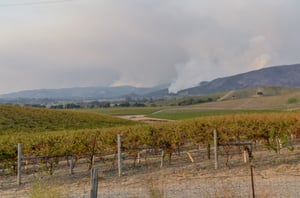Valuation of Wine Inventory: When Wine Goes up in Smoke
 Northern California’s famous wine country was scorched in 2020 by several major wildfires, including the LNU Lightning Complex Fire and the Glass Fire. Wildfires in the region have caused property damage and evacuations in three of the last six years.
Northern California’s famous wine country was scorched in 2020 by several major wildfires, including the LNU Lightning Complex Fire and the Glass Fire. Wildfires in the region have caused property damage and evacuations in three of the last six years.
Experts attribute the increasing numbers of destructive fires to the effects of climate change and an increase in the development of wild-urban interface areas. These factors have made conditions ripe for wildfires, which can ultimately be caused by:
- Lightning storms
- Human activity
- Electrical power/distribution lines
- Faulty electrical equipment
Wineries are impacted by fires in many ways, but some of the most sizable and complex claims relate to the destruction/damage of wine inventory, and it is important to note that wine does not have to be destroyed outright to be affected by a fire.
What Can Happen to Wine During a Wildfire?
The most common issue we see resulting in wine-related claims after a wildfire event is smoke taint. Although there is no evidence that smoke-tainted wine is harmful to consumer’s health, the wine will have an undesirable “smokey” taste with an “ashy” aftertaste.
Smoke taint can occur as a result of direct contact with smoke residue or through contact with aroma compounds released by fires.
After smoke taint has been detected during tasting, wineries will typically send samples to a third party for testing, where they will test for six volatile phenols that can lead to the smoke taint.
Key Steps to Valuing Wine
In most incidences, we will take the following steps to value wine:
Verify the Existence of the Wine
Our first step is to review the grape weigh tags for the impacted wine. This allows us to verify both the volume of the wine and the grape varietal.
During a normal harvest, after grapes have been picked from the vine, they will be taken to a weigh station, and a weighmaster certificate (commonly known as a “weigh tag”) will be produced, showing information such as the weigh date, grape varietal and appellation, and net weight. (Figure 1)
The weighing process is heavily regulated, and weight tags are mandated for all California wineries by both the Alcohol & Tobacco Tax & Trade Bureau and the California Alcoholic Beverage Control.
It should be noted that we also review inventory records and tank reports to verify the existence of the wine, but the weigh tag is considered the key source document.
Determine the Impacted Wine Program
To establish the projected selling value of the wine, we first must identify the program to which the wine would have been allocated. The “wine program” is the term for what you see on the label of the wine and will often specify the vineyard, if the wine is from a single vineyard, or may have a blend name if the wine is from multiple vineyards.
Our role involves scrutinizing the insured’s projected allocation to see if it is consistent with:
- Blending plans for that wine program and vintage
- Blending reports for prior vintages of the same program
- Comparable grapes blended in the allocated program
Calculate Sales Value and Unincurred Costs
Most insurance policies state the wine should be valued at “projected sales value less unincurred costs.”
Once we have established the program allocation, we then review sales records for the applicable wine program. This is done to establish both the average selling price of the wine and the sales channel.
Additional complications can arise if the impacted wine is a library wine (limited supply of a vintage held back after debut) as there is often limited sales data, and the projected sales price of the wine can be highly subjective. There is also a risk of obsolescence due to spoilage issues with older wines.
To calculate unincurred costs, we review both production and selling costs.
Mitigation Efforts
In some instances, the impacted wine may still be sellable, especially if there is only a mild impact on the taste. It may be possible for the insured to use the wine in a lower value wine program or sell the wine on the bulk market.
Coverage Complications
In smoke taint losses, the most common coverage complication centers on whether the wine falls under “crop” coverage (lower value) or “inventory” coverage (higher value).
This is often determined by identifying whether the grapes were on the vine or picked when the smoke taint occurred. To assist, we can look at the grape weigh tags to approximate the date the grapes were picked.
Changes to the Wine Insurance Market
Before 2019, the California wine industry had looked to Lloyd’s of London for inventory throughput policies. However, in July 2019, Lloyd’s announced that it would no longer be underwriting these policies because of the annual risk to wine production and storage caused by wildfires.
The move by Lloyd’s has put pressure on the domestic markets to respond. Furthermore, ongoing wildfires have resulted in significant increases in policy rates, particularly for large, high-end wineries with extremely valuable inventory. As a result, wineries have been forced to take on higher deductibles, and many will likely consider using dollars they would have otherwise spent on insurance policies for fire mitigation tools instead.
Hannah is a Director at Meaden & Moore and has over a decade of forensic accounting experience and specializes in insurance matters, commercial litigation and fraud investigations.










